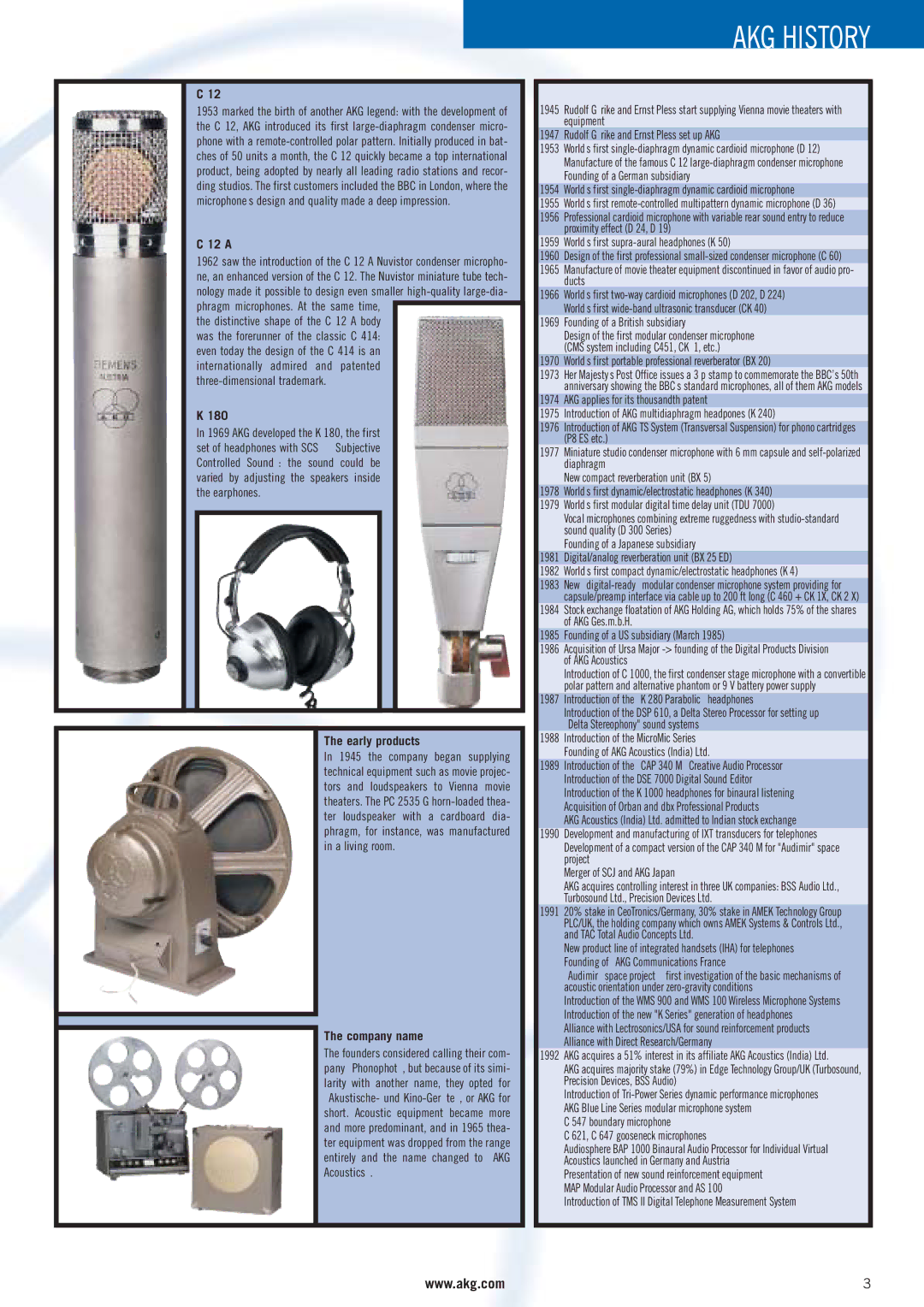C 12
1953 marked the birth of another AKG legend: with the development of the C 12, AKG introduced its first large-diaphragm condenser micro- phone with a remote-controlled polar pattern. Initially produced in bat- ches of 50 units a month, the C 12 quickly became a top international product, being adopted by nearly all leading radio stations and recor- ding studios. The first customers included the BBC in London, where the microphone’s design and quality made a deep impression.
C 12 A
1962 saw the introduction of the C 12 A Nuvistor condenser micropho- ne, an enhanced version of the C 12. The Nuvistor miniature tube tech- nology made it possible to design even smaller high-quality large-dia- phragm microphones. At the same time,
the distinctive shape of the C 12 A body was the forerunner of the classic C 414: even today the design of the C 414 is an internationally admired and patented three-dimensional trademark.
K 180
In 1969 AKG developed the K 180, the first set of headphones with SCS – “Subjective Controlled Sound”: the sound could be varied by adjusting the speakers inside the earphones.
The early products
In 1945 the company began supplying technical equipment such as movie projec- tors and loudspeakers to Vienna movie theaters. The PC 2535 G horn-loaded thea- ter loudspeaker with a cardboard dia- phragm, for instance, was manufactured in a living room.
The company name
The founders considered calling their com- pany “Phonophot”, but because of its simi- larity with another name, they opted for “Akustische- und Kino-Geräte“, or AKG for short. Acoustic equipment became more and more predominant, and in 1965 thea- ter equipment was dropped from the range entirely and the name changed to “AKG Acoustics”.
AKG HISTORY
1945 Rudolf Görike and Ernst Pless start supplying Vienna movie theaters with equipment
1947 Rudolf Görike and Ernst Pless set up AKG
1953 World’s first single-diaphragm dynamic cardioid microphone (D 12) Manufacture of the famous C 12 large-diaphragm condenser microphone Founding of a German subsidiary
1954 World’s first single-diaphragm dynamic cardioid microphone
1955 World’s first remote-controlled multipattern dynamic microphone (D 36)
1956 Professional cardioid microphone with variable rear sound entry to reduce proximity effect (D 24, D 19)
1959 World’s first supra-aural headphones (K 50)
1960 Design of the first professional small-sized condenser microphone (C 60)
1965 Manufacture of movie theater equipment discontinued in favor of audio pro- ducts
1966 World’s first two-way cardioid microphones (D 202, D 224) World’s first wide-band ultrasonic transducer (CK 40)
1969 Founding of a British subsidiary
Design of the first modular condenser microphone (CMS system including C451, CK 1, etc.)
1970 World’s first portable professional reverberator (BX 20)
1973 Her Majesty’s Post Office issues a 3 p stamp to commemorate the BBC's 50th anniversary showing the BBC’s standard microphones, all of them AKG models
1974 AKG applies for its thousandth patent
1975 Introduction of AKG multidiaphragm headpones (K 240)
1976 Introduction of AKG TS System (Transversal Suspension) for phono cartridges (P8 ES etc.)
1977 Miniature studio condenser microphone with 6 mm capsule and self-polarized diaphragm
New compact reverberation unit (BX 5)
1978 World’s first dynamic/electrostatic headphones (K 340)
1979 World’s first modular digital time delay unit (TDU 7000)
Vocal microphones combining extreme ruggedness with studio-standard sound quality (D 300 Series)
Founding of a Japanese subsidiary
1981 Digital/analog reverberation unit (BX 25 ED)
1982 World’s first compact dynamic/electrostatic headphones (K 4)
1983 New “digital-ready” modular condenser microphone system providing for capsule/preamp interface via cable up to 200 ft long (C 460 + CK 1X, CK 2 X)
1984 Stock exchange floatation of AKG Holding AG, which holds 75% of the shares of AKG Ges.m.b.H.
1985 Founding of a US subsidiary (March 1985)
1986 Acquisition of Ursa Major -> founding of the Digital Products Division of AKG Acoustics
Introduction of C 1000, the first condenser stage microphone with a convertible polar pattern and alternative phantom or 9 V battery power supply
1987 Introduction of the “K 280 Parabolic” headphones
Introduction of the DSP 610, a Delta Stereo Processor for setting up “Delta Stereophony" sound systems
1988 Introduction of the MicroMic Series
Founding of AKG Acoustics (India) Ltd.
1989 Introduction of the “CAP 340 M” Creative Audio Processor
Introduction of the DSE 7000 Digital Sound Editor Introduction of the K 1000 headphones for binaural listening Acquisition of Orban and dbx Professional Products
AKG Acoustics (India) Ltd. admitted to Indian stock exchange
1990 Development and manufacturing of IXT transducers for telephones
Development of a compact version of the CAP 340 M for "Audimir" space project
Merger of SCJ and AKG Japan
AKG acquires controlling interest in three UK companies: BSS Audio Ltd., Turbosound Ltd., Precision Devices Ltd.
1991 20% stake in CeoTronics/Germany, 30% stake in AMEK Technology Group PLC/UK, the holding company which owns AMEK Systems & Controls Ltd., and TAC Total Audio Concepts Ltd.
New product line of integrated handsets (IHA) for telephones Founding of “AKG Communications France”
“Audimir” space project – first investigation of the basic mechanisms of acoustic orientation under zero-gravity conditions
Introduction of the WMS 900 and WMS 100 Wireless Microphone Systems Introduction of the new "K Series" generation of headphones
Alliance with Lectrosonics/USA for sound reinforcement products Alliance with Direct Research/Germany
1992 AKG acquires a 51% interest in its affiliate AKG Acoustics (India) Ltd.
AKG acquires majority stake (79%) in Edge Technology Group/UK (Turbosound, Precision Devices, BSS Audio)
Introduction of Tri-Power Series dynamic performance microphones AKG Blue Line Series modular microphone system
C 547 boundary microphone
C 621, C 647 gooseneck microphones
Audiosphere BAP 1000 Binaural Audio Processor for Individual Virtual Acoustics launched in Germany and Austria
Presentation of new sound reinforcement equipment MAP Modular Audio Processor and AS 100
Introduction of TMS II Digital Telephone Measurement System

